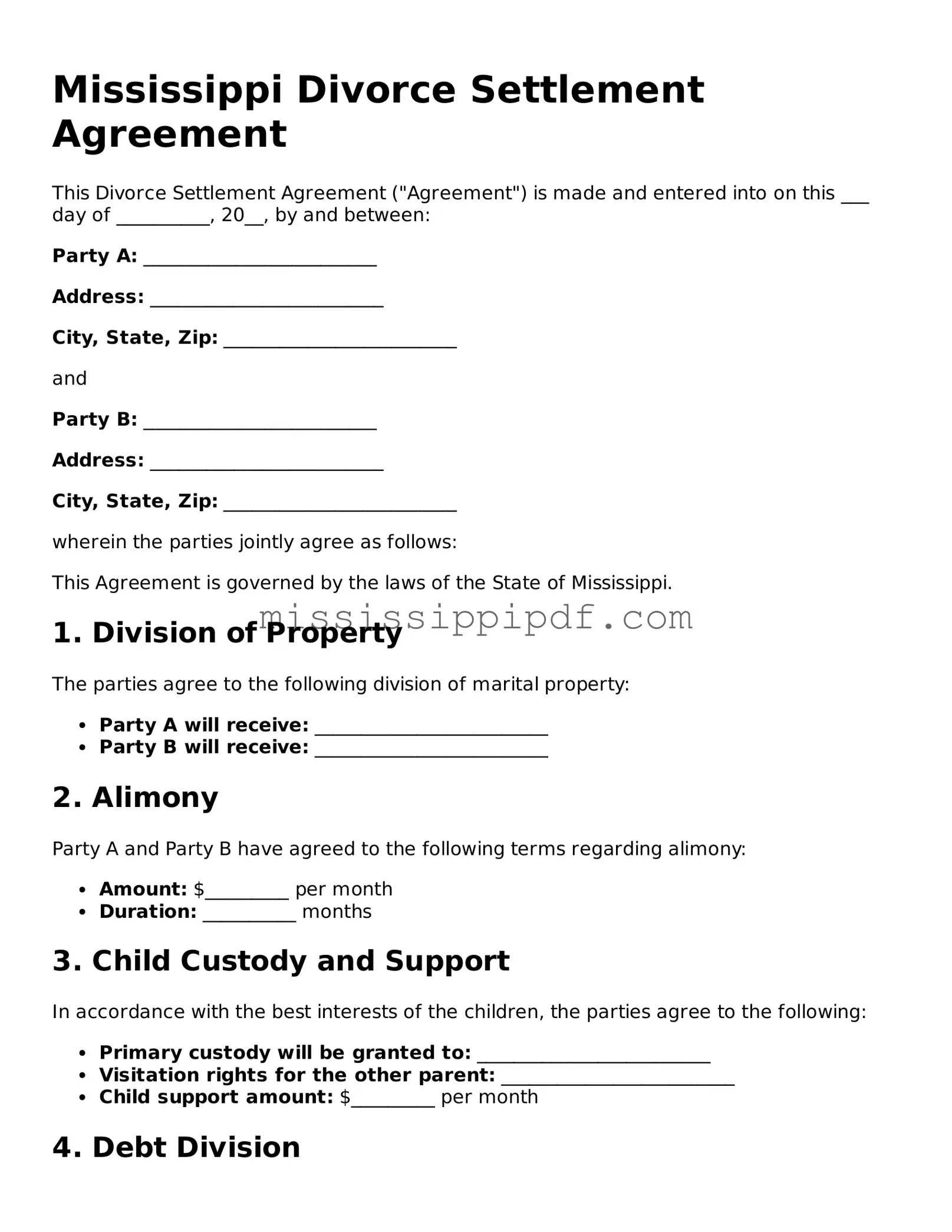The Child Custody Agreement is similar to the Mississippi Divorce Settlement Agreement as it outlines the terms of custody and visitation for children involved in a divorce. This document specifies where the children will live, how often they will see each parent, and how decisions regarding their upbringing will be made. Both agreements aim to ensure the best interests of the children while providing clear guidelines for parents.
The Property Settlement Agreement serves a similar purpose by detailing the division of marital assets and debts during a divorce. Like the Divorce Settlement Agreement, it helps both parties understand their rights and responsibilities regarding property. This document can include real estate, bank accounts, and personal belongings, ensuring a fair distribution between the spouses.
The Spousal Support Agreement is another document that resembles the Divorce Settlement Agreement. This agreement outlines any financial support one spouse may provide to the other after the divorce. It details the amount, duration, and conditions of the support, ensuring both parties have a clear understanding of their financial obligations moving forward.
The Parenting Plan is closely related to the Child Custody Agreement but goes further by addressing daily parenting responsibilities. It includes schedules for holidays, education, and healthcare, similar to how the Divorce Settlement Agreement addresses various aspects of the divorce. Both documents emphasize cooperation between parents for the benefit of their children.
The Separation Agreement, while often used before a divorce is finalized, serves a similar function to the Divorce Settlement Agreement. It outlines the terms of the couple's separation, including financial responsibilities and child custody arrangements. This document can be converted into a Divorce Settlement Agreement once the divorce is filed.
The Marital Settlement Agreement is another document that aligns with the Divorce Settlement Agreement. It encompasses all aspects of the divorce, including child custody, property division, and spousal support. Both documents aim to resolve disputes amicably and provide a comprehensive plan for the future.
The Collaborative Divorce Agreement is similar in that it emphasizes cooperation between both parties. This document is part of a collaborative divorce process, where both spouses work together to reach a settlement. Like the Divorce Settlement Agreement, it focuses on mutual understanding and aims to reduce conflict during the divorce process.
The NYC Payroll form, designed by the Department of Labor Bureau of Public Work, is essential for contractors managing employee compensation. It provides a structured approach to record necessary details such as hours worked, pay rates, and deductions, thus ensuring compliance with regulatory mandates. For anyone looking to learn more about these payroll requirements, a useful resource can be found at nyforms.com, which offers insights and tools to streamline the payroll process.
The Mediation Agreement often arises during divorce proceedings and can be similar to the Divorce Settlement Agreement. This document outlines the terms agreed upon during mediation sessions. It helps to formalize the outcomes of discussions between the parties, ensuring that both sides understand their commitments.
The Consent Order is another document that shares similarities with the Divorce Settlement Agreement. It is a court order that reflects the agreements made by both parties regarding custody, support, or property division. This document ensures that the terms are enforceable by the court, similar to how a Divorce Settlement Agreement provides a legally binding framework for the divorce.
The Final Judgment of Divorce is the official court document that concludes the divorce process. While it is different from the Divorce Settlement Agreement, it incorporates the terms outlined in that agreement. This document finalizes the divorce and ensures that all previously agreed-upon terms are legally recognized.
